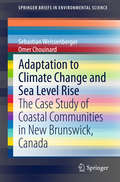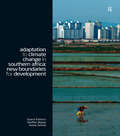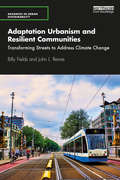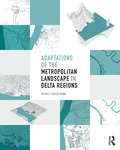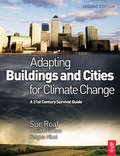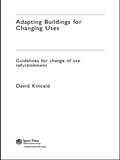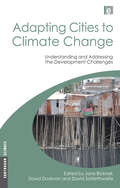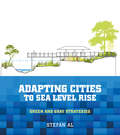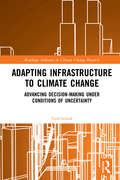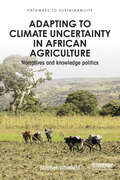- Table View
- List View
Adaptation to Climate Change and Sea Level Rise: The Case Study of Coastal Communities in New Brunswick, Canada (SpringerBriefs in Environmental Science)
by Sebastian Weissenberger Omer ChouinardThe book provides a concise and interdisciplinary outlook on the impacts of climate change on coastal areas and how coastal communities adapt to them. The first chapter analyses how sea level rise, changing ocean conditions, or increased climate variability and the socio-environmental context of the coastal zone leads to vulnerable communities. The second chapter addresses adaptation strategies and tools, and gives some examples of their application around the world. The third chapter describes participative action research projects undertaken in New Brunswick and how this community based approach has enabled communities to increase their climate resilience.
Adaptation to Climate Change in Southern Africa: New Boundaries for Development (Climate and Development Series)
by Steffen Bauer Imme ScholzAdverse climate impacts are already evident across Southern Africa and pose a serious threat to the development prospects of the region's societies. Sustainable development in this region will depend on the rapid development and implementation of effective adaptation measures. This volume identifies the new socioeconomic and political boundaries to development that result from ongoing climate change in Southern Africa. The collected papers explore the region's potential for a transition to development strategies that combine meaningful socioeconomic investment and adaptation measures while also improving livelihoods in the region. The chapters are backed up by detailed case studies which underscore the urgent need for national governments and multilateral agencies to develop strategies to support Southern Africa's societies in adapting to climate change.
Adaptation to Climate Change in Southern Africa: New Boundaries for Development (Climate and Development Series)
by Steffen Bauer Imme ScholzAdverse climate impacts are already evident across Southern Africa and pose a serious threat to the development prospects of the region's societies. Sustainable development in this region will depend on the rapid development and implementation of effective adaptation measures. This volume identifies the new socioeconomic and political boundaries to development that result from ongoing climate change in Southern Africa. The collected papers explore the region's potential for a transition to development strategies that combine meaningful socioeconomic investment and adaptation measures while also improving livelihoods in the region. The chapters are backed up by detailed case studies which underscore the urgent need for national governments and multilateral agencies to develop strategies to support Southern Africa's societies in adapting to climate change.
Adaptation under Fire: How Militaries Change in Wartime (BRIDGING THE GAP SERIES)
by Nora Bensahel Lt. General David BarnoA critical look into how and why the U.S. military needs to become more adaptable. Every military must prepare for future wars despite not really knowing the shape such wars will ultimately take. As former U.S. Secretary of Defense Robert Gates once noted: "We have a perfect record in predicting the next war. We have never once gotten it right." In the face of such great uncertainty, militaries must be able to adapt rapidly in order to win. Adaptation under Fire identifies the characteristics that make militaries more adaptable, illustrated through historical examples and the recent wars in Iraq and Afghanistan. Authors David Barno and Nora Bensahel argue that militaries facing unknown future conflicts must nevertheless make choices about the type of doctrine that their units will use, the weapons and equipment they will purchase, and the kind of leaders they will select and develop to guide the force to victory. Yet after a war begins, many of these choices will prove flawed in the unpredictable crucible of the battlefield. For a U.S. military facing diverse global threats, its ability to adapt quickly and effectively to those unforeseen circumstances may spell the difference between victory and defeat. Barno and Bensahel start by providing a framework for understanding adaptation and include historical cases of success and failure. Next, they examine U.S. military adaptation during the nation's recent wars, and explain why certain forms of adaptation have proven problematic. In the final section, Barno and Bensahel conclude that the U.S. military must become much more adaptable in order to address the fast-changing security challenges of the future, and they offer recommendations on how to do so before it is too late.
Adaptation under Fire: How Militaries Change in Wartime (Bridging the Gap)
by Nora Bensahel Lt. General David BarnoA critical look into how and why the U.S. military needs to become more adaptable. Every military must prepare for future wars despite not really knowing the shape such wars will ultimately take. As former U.S. Secretary of Defense Robert Gates once noted: "We have a perfect record in predicting the next war. We have never once gotten it right." In the face of such great uncertainty, militaries must be able to adapt rapidly in order to win. Adaptation under Fire identifies the characteristics that make militaries more adaptable, illustrated through historical examples and the recent wars in Iraq and Afghanistan. Authors David Barno and Nora Bensahel argue that militaries facing unknown future conflicts must nevertheless make choices about the type of doctrine that their units will use, the weapons and equipment they will purchase, and the kind of leaders they will select and develop to guide the force to victory. Yet after a war begins, many of these choices will prove flawed in the unpredictable crucible of the battlefield. For a U.S. military facing diverse global threats, its ability to adapt quickly and effectively to those unforeseen circumstances may spell the difference between victory and defeat. Barno and Bensahel start by providing a framework for understanding adaptation and include historical cases of success and failure. Next, they examine U.S. military adaptation during the nation's recent wars, and explain why certain forms of adaptation have proven problematic. In the final section, Barno and Bensahel conclude that the U.S. military must become much more adaptable in order to address the fast-changing security challenges of the future, and they offer recommendations on how to do so before it is too late.
Adaptation Urbanism and Resilient Communities: Transforming Streets to Address Climate Change (Advances in Urban Sustainability)
by Billy Fields John L. RenneAdaptation Urbanism and Resilient Communities outlines and explains adaptation urbanism as a theoretical framework for understanding and evaluating resilience projects in cities and relates it to pressing contemporary policy issues related to urban climate change mitigation and adaptation. Through a series of detailed case studies, this book uncovers the promise and tensions of a new wave of resilient communities in Europe (Copenhagen, Rotterdam, and London), and the United States (New Orleans and South Florida). In addition, best practice projects in Amsterdam, Barcelona, Delft, Utrecht, and Vancouver are examined. The authors highlight how these communities are reinventing the role of streets and connecting public spaces in adapting to and mitigating climate change through green/blue infrastructure planning, maintaining and enhancing sustainable transportation options, and struggling to ensure equitable development for all residents. The case studies demonstrate that while there are some more universal aspects to encouraging adaptation urbanism, there are also important local characteristics that need to be both acknowledged and celebrated to help local communities thrive in the era of climate change. The book also provides key policy lessons and a roadmap for future research in adaptation urbanism. Advancing resilience policy discourse through multidisciplinary framework this work will be of great interest to students of urban planning, geography, transportation, landscape architecture, and environmental studies, as well as resilience practitioners around the world.
Adaptation Urbanism and Resilient Communities: Transforming Streets to Address Climate Change (Advances in Urban Sustainability)
by Billy Fields John L. RenneAdaptation Urbanism and Resilient Communities outlines and explains adaptation urbanism as a theoretical framework for understanding and evaluating resilience projects in cities and relates it to pressing contemporary policy issues related to urban climate change mitigation and adaptation. Through a series of detailed case studies, this book uncovers the promise and tensions of a new wave of resilient communities in Europe (Copenhagen, Rotterdam, and London), and the United States (New Orleans and South Florida). In addition, best practice projects in Amsterdam, Barcelona, Delft, Utrecht, and Vancouver are examined. The authors highlight how these communities are reinventing the role of streets and connecting public spaces in adapting to and mitigating climate change through green/blue infrastructure planning, maintaining and enhancing sustainable transportation options, and struggling to ensure equitable development for all residents. The case studies demonstrate that while there are some more universal aspects to encouraging adaptation urbanism, there are also important local characteristics that need to be both acknowledged and celebrated to help local communities thrive in the era of climate change. The book also provides key policy lessons and a roadmap for future research in adaptation urbanism. Advancing resilience policy discourse through multidisciplinary framework this work will be of great interest to students of urban planning, geography, transportation, landscape architecture, and environmental studies, as well as resilience practitioners around the world.
Adaptations of the Metropolitan Landscape in Delta Regions
by Peter C BosselmannAdaptations of the Metropolitan Landscape in Delta Regions is about environmental quality and the long term livability of urban areas. In decades to come, climate change will affect cities everywhere, but nowhere have the effects of climate change already been felt as strongly as in low-lying coastal cities, cities located in large river deltas and near tidal estuaries. This book reflects on the contribution that spatial planning and urban design can make to a complex discussion about how city form and landscapes will need to adapt within metropolitan areas. The book’s focus is on the urban form of three delta regions: the Pearl River Delta in Southern China; the Rhine, Maas, and Scheldt Delta in the Netherlands; and the San Francisco Bay Area in Northern California. The three regions differ greatly, but despite their different political systems, history, culture and locations in three different climate zones, all three regions will be forced to respond to similar issues that will trigger transformations and adaptations to their urban form. Richly illustrated in color with detailed diagrams, models, photographs and sketches, the book is written for students, scholars and practitioners of environmental planning, and designers who need to respond to the future form of cities in light of climate change. For the professions shaping the physical world of cities and regions, the challenge is not only one of designing physical geometries but of social consequences.
Adaptations of the Metropolitan Landscape in Delta Regions
by Peter C BosselmannAdaptations of the Metropolitan Landscape in Delta Regions is about environmental quality and the long term livability of urban areas. In decades to come, climate change will affect cities everywhere, but nowhere have the effects of climate change already been felt as strongly as in low-lying coastal cities, cities located in large river deltas and near tidal estuaries. This book reflects on the contribution that spatial planning and urban design can make to a complex discussion about how city form and landscapes will need to adapt within metropolitan areas. The book’s focus is on the urban form of three delta regions: the Pearl River Delta in Southern China; the Rhine, Maas, and Scheldt Delta in the Netherlands; and the San Francisco Bay Area in Northern California. The three regions differ greatly, but despite their different political systems, history, culture and locations in three different climate zones, all three regions will be forced to respond to similar issues that will trigger transformations and adaptations to their urban form. Richly illustrated in color with detailed diagrams, models, photographs and sketches, the book is written for students, scholars and practitioners of environmental planning, and designers who need to respond to the future form of cities in light of climate change. For the professions shaping the physical world of cities and regions, the challenge is not only one of designing physical geometries but of social consequences.
Adapting Buildings and Cities for Climate Change
by David Crichton Fergus Nicol Sue RoafFrom the bestselling author of Ecohouse, this fully revised edition of Adapting Buildings and Cities for Climate Change provides unique insights into how we can protect our buildings, cities, infra-structures and lifestyles against risks associated with extreme weather and related social, economic and energy events. Three new chapters present evidence of escalating rates of environmental change. The authors explore the growing urgency for mitigation and adaptation responses that deal with the resulting challenges. Theoretical information sits alongside practical design guidelines, so architects, designers and planners can not only see clearly what problems they face, but also find the solutions they need, in order to respond to power and water supply needs. Considers use of materials, structures, site issues and planning in order to provide design solutions. Examines recent climate events in the US and UK and looks at how architecture was successful or not in preventing building damage. Adapting Buildings and Cities for Climate Change is an essential source, not just for architects, engineers and planners facing the challenges of designing our building for a changing climate, but also for everyone involved in their production and use.
Adapting Buildings and Cities for Climate Change: A 21st Century Survival Guide
by David Crichton Fergus Nicol Sue RoafFrom the bestselling author of Ecohouse, this fully revised edition of Adapting Buildings and Cities for Climate Change provides unique insights into how we can protect our buildings, cities, infra-structures and lifestyles against risks associated with extreme weather and related social, economic and energy events. Three new chapters present evidence of escalating rates of environmental change. The authors explore the growing urgency for mitigation and adaptation responses that deal with the resulting challenges. Theoretical information sits alongside practical design guidelines, so architects, designers and planners can not only see clearly what problems they face, but also find the solutions they need, in order to respond to power and water supply needs. Considers use of materials, structures, site issues and planning in order to provide design solutions. Examines recent climate events in the US and UK and looks at how architecture was successful or not in preventing building damage. Adapting Buildings and Cities for Climate Change is an essential source, not just for architects, engineers and planners facing the challenges of designing our building for a changing climate, but also for everyone involved in their production and use.
Adapting Buildings for Changing Uses: Guidelines for Change of Use Refurbishment
by David KincaidAdapting Building for Changing Uses discusses the comprehensive refurbishment of buildings to enable them to be used for purposes different to those originally intended.For those involved in the often risky business of conversion of buildings from one type of use to another, Adapting Building for Changing Uses provides secure guidance on which uses may be best suited to a particular location. This guidance is based on a unique decision tool, the "Use Comparator", which was developed through research carried out at UCL in the mid 1990's. The "Use Comparator" compares the physical and locational characteristics of a building with the characteristics best suited to various types of use. A total of 77 targeted types of use are evaluated, in contrast to the 17 uses normally considers by regulatory planners.Adapting Building for Changing Uses also identifies the key problems experienced by building managers involved in assembling the coalition of Producers, Investors, Marketeers, Regulators and Users, which makes the key decisions in "Adaptive Reuse". The book explores the differing perceptions and attitudes of these key decision agents to matters such as cost, value, risk and robustness, and offers advice on how to avoid the potential for project failure that these differences present.
Adapting Buildings for Changing Uses: Guidelines for Change of Use Refurbishment
by David KincaidAdapting Building for Changing Uses discusses the comprehensive refurbishment of buildings to enable them to be used for purposes different to those originally intended.For those involved in the often risky business of conversion of buildings from one type of use to another, Adapting Building for Changing Uses provides secure guidance on which uses may be best suited to a particular location. This guidance is based on a unique decision tool, the "Use Comparator", which was developed through research carried out at UCL in the mid 1990's. The "Use Comparator" compares the physical and locational characteristics of a building with the characteristics best suited to various types of use. A total of 77 targeted types of use are evaluated, in contrast to the 17 uses normally considers by regulatory planners.Adapting Building for Changing Uses also identifies the key problems experienced by building managers involved in assembling the coalition of Producers, Investors, Marketeers, Regulators and Users, which makes the key decisions in "Adaptive Reuse". The book explores the differing perceptions and attitudes of these key decision agents to matters such as cost, value, risk and robustness, and offers advice on how to avoid the potential for project failure that these differences present.
Adapting Cities to Climate Change: Understanding and Addressing the Development Challenges
by David Dodman Jane Bicknell David SatterthwaiteThis volume brings together, for the first time, a wide-ranging and detailed body of information identifying and assessing risk, vulnerability and adaptation to climate change in urban centres in low- and middle-income countries. Framed by an overview of the main possibilities and constraints for adaptation, the contributors examine the implications of climate change for cities in Africa, Asia and Latin America, and propose innovative agendas for adaptation. The book should be of interest to policy makers, practitioners and academics who face the challenge of addressing climate change vulnerability and adaptation in urban centres throughout the global South. Published with E&U and International Institute for Environment and Development
Adapting Cities to Climate Change: Understanding and Addressing the Development Challenges
by David Dodman Jane Bicknell David SatterthwaiteThis volume brings together, for the first time, a wide-ranging and detailed body of information identifying and assessing risk, vulnerability and adaptation to climate change in urban centres in low- and middle-income countries. Framed by an overview of the main possibilities and constraints for adaptation, the contributors examine the implications of climate change for cities in Africa, Asia and Latin America, and propose innovative agendas for adaptation. The book should be of interest to policy makers, practitioners and academics who face the challenge of addressing climate change vulnerability and adaptation in urban centres throughout the global South. Published with E&U and International Institute for Environment and Development
Adapting Cities to Sea Level Rise: Green and Gray Strategies
by Stefan AlIn 2012, Hurricane Sandy floods devastated coastal areas in New York and New Jersey. In 2017, Harvey flooded Houston. Today in Miami, even on sunny days, king tides bring fish swimming through the streets in low-lying areas. These types of events are typically called natural disasters. But overwhelming scientific consensus says they are actually the result of human-induced climate change and irresponsible construction inside floodplains.As cities build more flood-management infrastructure to adapt to the effects of a changing climate, they must go beyond short-term flood protection and consider the long-term effects on the community, its environment, economy, and relationship with the water. Adapting Cities to Sea Level Rise, by infrastructure expert Stefan Al, introduces design responses to sea-level rise, drawing from examples around the globe. Going against standard engineering solutions, Al argues for approaches that are integrated with the public realm, nature-based, and sensitive to local conditions and the community. He features design responses to building resilience that creates new civic assets for cities. For the first time, the possible infrastructure solutions are brought together in a clear and easy-to-read format.The first part of the book looks at the challenges for cities that have historically faced sea-level rise and flooding issues, and their response in resiliency through urban design. He presents diverse case studies from New Orleans to Ho Chi Minh to Rotterdam, and draws best practices and urban design typologies for the second part of the book. Part two is a graphic catalogue of best-practices or resilience strategies. These strategies are organized into four categories: hard protect, soft protect, store, and retreat. The benefits and challenges of each strategy are outlined and highlighted by a case study showing where that strategy has been applied.Any professional or policymaker in coastal areas seeking to protect their communities from the effects of climate change should start with this book. With the right solutions, Al shows, sea-level rise can become an opportunity to improve our urban areas and landscapes, rather than a threat to our communities.
Adapting Infrastructure to Climate Change: Advancing Decision-Making Under Conditions of Uncertainty (Routledge Advances in Climate Change Research)
by Todd SchenkMany of the challenges that decision-makers grapple with in relation to climate change are governance related. Planning and decision-making is evolving in ambiguous institutional environments, in which many key issues remain unresolved, including relationships between different actors; funding arrangements; and the sources and procedures for vetting data. These issues are particularly acute at this juncture, as climate adaptation moves from broad planning processes to the management of infrastructure systems. Concrete decisions must be made. Adapting Infrastructure to Climate Change draws on case studies of three coastal cities situated within very different governance regimes: neo-corporatist Rotterdam, neo-pluralist Boston and semi-authoritarian Singapore. The book examines how infrastructure managers and other stakeholders grappling with complex and uncertain climate risks are likely to make project-level decisions in practice, and how more effective decision-making can be supported. The differences across governance regimes are currently unaccounted for in adaptation planning, but are crucial as best practices are devised. These lessons are also applicable to infrastructure planning and decision-making in other contexts. This book will be of great interest to scholars of climate change and environmental policy and governance, particularly in the context of infrastructure management.
Adapting Infrastructure to Climate Change: Advancing Decision-Making Under Conditions of Uncertainty (Routledge Advances in Climate Change Research)
by Todd SchenkMany of the challenges that decision-makers grapple with in relation to climate change are governance related. Planning and decision-making is evolving in ambiguous institutional environments, in which many key issues remain unresolved, including relationships between different actors; funding arrangements; and the sources and procedures for vetting data. These issues are particularly acute at this juncture, as climate adaptation moves from broad planning processes to the management of infrastructure systems. Concrete decisions must be made. Adapting Infrastructure to Climate Change draws on case studies of three coastal cities situated within very different governance regimes: neo-corporatist Rotterdam, neo-pluralist Boston and semi-authoritarian Singapore. The book examines how infrastructure managers and other stakeholders grappling with complex and uncertain climate risks are likely to make project-level decisions in practice, and how more effective decision-making can be supported. The differences across governance regimes are currently unaccounted for in adaptation planning, but are crucial as best practices are devised. These lessons are also applicable to infrastructure planning and decision-making in other contexts. This book will be of great interest to scholars of climate change and environmental policy and governance, particularly in the context of infrastructure management.
Adapting the United Nations to a Post-Modern Era: Lessons Learned (Global Issues)
by W. KnightThis volume addresses the central theme of adjusting the United Nations system in light of, firstly, the broadening definition of security, secondly, a perceived shift from modernity to post-modernity; and finally, the contemporary debate about reform, adaptation and institutional learning in multilateral institutions during transnational periods. The UN has not been successful in learning appropriate lessons that could facilitate requisite changes to its structure and operations. Thus the authors in this study focus on the lessons learned from the organizations' recent performance in collective security, preventative diplomacy, preventative deployment, peacekeeping, peacemaking, peace maintenance, and international legal, environmental and trade regulation.
Adapting to Climate Uncertainty in African Agriculture: Narratives and knowledge politics (Pathways to Sustainability)
by Stephen WhitfieldFuture climatic and agro-ecological changes in Africa are uncertain and associated with high degrees of spatial and temporal variability and this change is differently simulated within divergent climate-crop models and in controlled crop breeding stations. Furthermore, uncertainty emerges in local contexts, not just in response to climatic systems, but to social, economic, and political systems, and often with implications for the appropriateness and adoption of technologies or the success of alternative cropping systems. This book examines the challenges of adaptation in smallholder farming in Africa, analysing the social, economic, political and climatic uncertainties that impact on agriculture in the region and the range of solutions proposed. Drawing on case studies of genetically modified crops, conservation agriculture, and other 'climate smart' solutions in eastern and southern Africa, the book identifies how uncertainties are framed 'from above' as well experienced 'from below', by farmers themselves. It provides a compelling insight into why ideas about adaptation emerge, from whom, and with what implications. This book offers a unique perspective and will be highly relevant to students of climate change adaptation, food security and poverty alleviation, as well as policy-makers and field practitioners in international development and agronomy.
Adapting to Climate Uncertainty in African Agriculture: Narratives and knowledge politics (Pathways to Sustainability)
by Stephen WhitfieldFuture climatic and agro-ecological changes in Africa are uncertain and associated with high degrees of spatial and temporal variability and this change is differently simulated within divergent climate-crop models and in controlled crop breeding stations. Furthermore, uncertainty emerges in local contexts, not just in response to climatic systems, but to social, economic, and political systems, and often with implications for the appropriateness and adoption of technologies or the success of alternative cropping systems. This book examines the challenges of adaptation in smallholder farming in Africa, analysing the social, economic, political and climatic uncertainties that impact on agriculture in the region and the range of solutions proposed. Drawing on case studies of genetically modified crops, conservation agriculture, and other 'climate smart' solutions in eastern and southern Africa, the book identifies how uncertainties are framed 'from above' as well experienced 'from below', by farmers themselves. It provides a compelling insight into why ideas about adaptation emerge, from whom, and with what implications. This book offers a unique perspective and will be highly relevant to students of climate change adaptation, food security and poverty alleviation, as well as policy-makers and field practitioners in international development and agronomy.
Adapting to EU Multi-Level Governance: Regional and Environmental Policies in Cohesion and CEE Countries
by CHRISTOS PARASKEVOPOULOS, PANAGIOTIS GETIMIS AND NICHOLAS REESThe main theme of this book is the adaptation process of the new EU member states from Central-Eastern Europe (Hungary and Poland) to the multi-level system of governance in public policy, particularly in the regional and environmental policy areas. The work conceptualizes policy learning and institutional and policy adaptation within the EU system of governance and draws lessons from the experience of previous waves of enlargement-cohesion-countries (Ireland, Portugal and Greece). In doing so, the book makes an important contribution to the literature on the transformation of domestic policy-making structures, as a result of the increasing Europeanization of public policy, as well as on the conceptual tools, explanatory variables and mechanisms determining this process.
Adapting to EU Multi-Level Governance: Regional and Environmental Policies in Cohesion and CEE Countries
by C. J Paraskevopoulos P. Getimis N. ReesThe main theme of this book is the adaptation process of the new EU member states from Central-Eastern Europe (Hungary and Poland) to the multi-level system of governance in public policy, particularly in the regional and environmental policy areas. The work conceptualizes policy learning and institutional and policy adaptation within the EU system of governance and draws lessons from the experience of previous waves of enlargement-cohesion-countries (Ireland, Portugal and Greece). In doing so, the book makes an important contribution to the literature on the transformation of domestic policy-making structures, as a result of the increasing Europeanization of public policy, as well as on the conceptual tools, explanatory variables and mechanisms determining this process.
Adapting to European Integration: Small States and the European Union
by Kenneth Hanf Ben SoetendorpAdapting to European Integration describes how the political institutions in eight small member states and two non-members responded to the internal and external demands springing from the process of European integration in general and EC/EU membership in particular. The study makes a distinction between governmental/administrative adaptation, political adaptation and strategic adaptation. The chapters focus, in the first instance, on the governmental/administrative responses at the level of central government, the organisational adjustments and the changes in institutional capacity to meet the new challenges. The authors also look at the willingness of the political decision-makers to internalise the EC/EU dimension in domestic policy making and the way in which the country's own history as well as the attitude towards European integration facilitate or hinder adaptation and change.
Adapting to European Integration: Small States and the European Union
by Kenneth Hanf Ben SoetendorpAdapting to European Integration describes how the political institutions in eight small member states and two non-members responded to the internal and external demands springing from the process of European integration in general and EC/EU membership in particular. The study makes a distinction between governmental/administrative adaptation, political adaptation and strategic adaptation. The chapters focus, in the first instance, on the governmental/administrative responses at the level of central government, the organisational adjustments and the changes in institutional capacity to meet the new challenges. The authors also look at the willingness of the political decision-makers to internalise the EC/EU dimension in domestic policy making and the way in which the country's own history as well as the attitude towards European integration facilitate or hinder adaptation and change.
